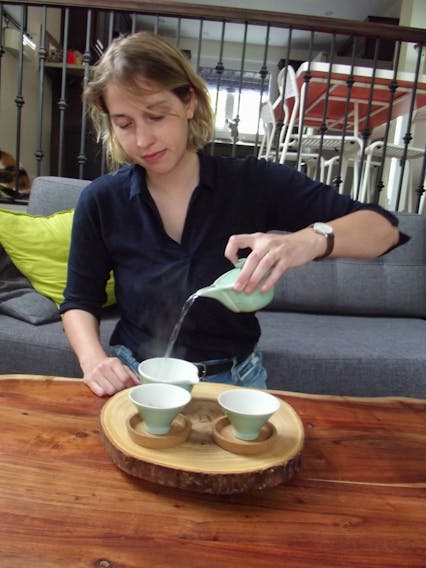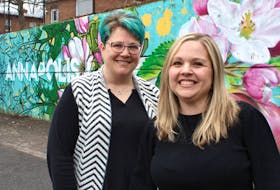For Dartmouth’s Mel Hattie, tea is more a hot drink on a cold day, or a chilled drink on a warm day.
Tea is an experience.
“The idea of tea is the idea of self-care, and taking a moment for reflection, which as a writer and an introvert has always been very important to me,” said Hattie during an interview this summer.
This is evident as she places a hot water kettle next to Houchin tea set from the Asahiyaki kiln, which has been making tea sets for over 400 years. While waiting for the leaves to steep, she talks about different types of teas and their histories. She also keeps a careful eye on the tea itself.
“I’m doing a long steep just because I know it will make the leaves look really cool,” says Hattie.
“With an oolong you can get two to three steeps of it. Normally, I would do a 15-second steep and a 20-second steep, then a 25-second steep, so you’re never steeping it as long and you’re getting subtle variations of flavour.”
When it’s done, she pours a bit into a tea cup, taking a sip to ensure it tastes just right.
Along with drinking tea the beverage is also, sometimes, her job. Hattie is a tea sommelier.
“It’s similar to being a wine sommelier,” says Hattie, who is also a journalist, photographer, blogger and marketing manager.
“It’s really cool; you just learn about teas: the origin, the history, and do a lot of tasting."

Hattie wasn’t looking for the course, but it came at the right time. She was between degrees and working at a law firm, but “wasn’t’ really happy with it.” She was scrolling through Facebook when she noticed an ad for the Tea Association of Canada’s sommelier course.
“I missed studying so I was like I should do this,” she says. “With it, I started talking to a lot more shop owners and tea traders and people in the business, and I just thought it was so cool how people drank tea for a living and travelled the globe. I wanted to be part of this world.”
And she has. Her travels include visits to Japan, the United Kingdom, South Korea and Iceland, among others. She’s also brought her knowledge and skills to Halifax.
Since becoming a sommelier she’s done classes and workshops at places like The World Tea House. Her most recent one with café was on Japanese tea, soon after returning from the Obubu Tea Farms in Japan.
“It was fantastic,” says World Tea House owner Phil Holmans, who learned a thing or two himself.
“The last one she did on Japanese teas, some of them I didn’t even try. So, during a recent trip, I made a point of going out there and trying these teas, so she introduced me to stuff I didn’t know existed, which is kind of a cool thing to have happen.”
Introducing people to new teas, or new approaches to tea, is something Hattie loves doing.
“The best part about introducing people to new teas is to get them to experience something they might have thought of as boring and transforming it into an exciting sensory experience,” she said.
"The idea is even if you’re in your bedroom in Dartmouth, you can be drinking something that connects you to a different country."
- Mel Hattie
While it got her to the tea sommelier level, Hattie’s interest in tea didn’t start with targeted advertising on Facebook. It’s always been part of her life, she says.
In high school she had a tea journal, where she’d collect tabs from tea bag strings and rate the teas. In 2012, while on exchange in Japan, she started her blog, Mel Had Tea, to document her experiences.
“Blogging is great because it connects you to a wider audience that have the same interest as you,” says Hattie, adding she was able to combine all of her interests: writing, tea and photography into one thing.
The blog’s name is an accidental pun on her name. It comes from her Twitter user name, which she chose because Mel Hattie was already taken.
“It became such a self-fulfilling prophecy because I got that handle on Twitter, but I wasn’t thinking that this tea thing would be something,” she says. “It was an off the cuff thing.”
She’s also been able to connect to others through the blog, whether people are suggesting a tea for her to try or a company reaching out for a review.
Holmans says she’s been an asset to him and the World Tea House as a small business.
“For a business like ours (the World Tea House) to survive as long as we have, it’s rare. We have a really good following and good product and people like Mel help with that,” he says.
“She’s a good one to bounce a new tea off of when I bring something new in and give me an honest opinion.”
This year, Hattie’s efforts paid off when she was nominated for blog of the year at the World Tea Expo in Las Vegas.
“It was very exciting. My first reaction was, ‘I need to make this blog better than ever,’ to continue to serve the amazing readers that come to it,” she says. “My second reaction was, ‘holy crap, these other nominees are really amazing.”
Even though she didn’t win, Hattie found the nomination encouraging.
“The whole experience was like hiking up a mountain and then coming across a really nice, unexpected view,” she says. “(I am) very thankful for it, and I’ll continue my journey up tea mountain.”
Currently Hattie has plans to grow Mel Had Tea and, perhaps, do a bit more travelling.
Even if she isn’t travelling, she still be connected to the tea world.
“The idea is even if you’re in your bedroom in Dartmouth, you can be drinking something that connects you to a different country,” she says. “That’s really cool; it’s something I’ve always liked.”
MEL'S TOP FIVE
Mel Hattie enjoys many different types of teas, but even a tea expert has a few favourites. The following are Hattie’s top five, in no particular order.
1. Taiwanese oolongs
2. Japanese sencha
3. Darjeeling black tea from India
4. Matcha from Japan
5. Breakfast blends with black tea from Assam in India and Kenya.









